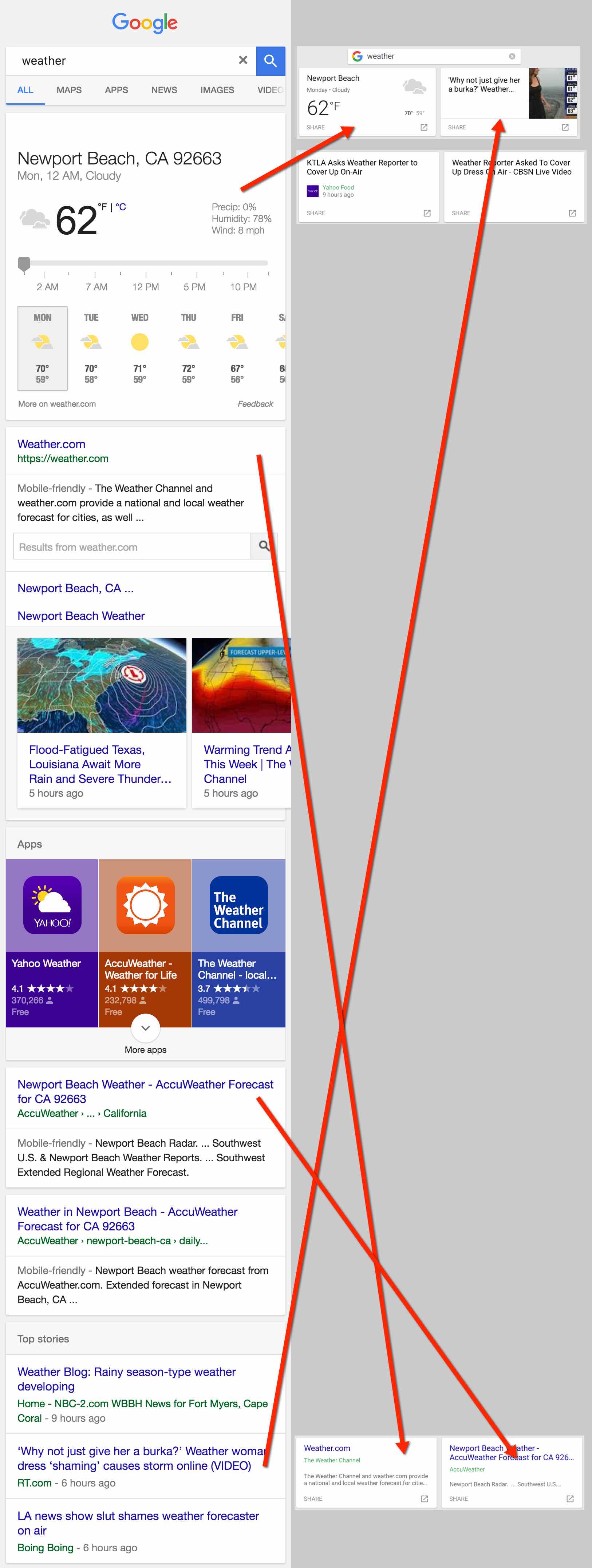
Vertical search results are so last year. Gboard — Google’s new keyboard for iOS with integrated searching that launched last week — flips Google’s search results 90 degrees. In addition to the the new horizontal format, exactly what’s shown may differ from regular mobile search listings.
Gboard listings: based on mobile search but different
Rajan Patel, a principal engineer at Google who oversees mobile search, including Gboard, told Search Engine Land that Gboard’s rankings are largely based off the same algorithms used to generate Google’s mobile search results. However, anyone comparing searches from within a mobile browser like Chrome or Safari to Gboard matches will likely find differences for a variety of reasons.
“It’s really early, so we’re kind of experimenting with what the ranking is for the right use case,â€Â Patel said.
For one, Patel said that Gboard may give preference to moving direct answers higher, if it has confidence about these. For example, a Knowledge Graph answer about a company might come midway in mobile results but move to the first listing with Gboard.
News listings are likely to be shown higher in Gboard listings. This is because keyboard-based searchers may be doing some type of sharing activity, such as posting a status update or a message. In such cases, Google’s making an assumption that recent information such as news stories may be more useful, Patel said.
When news listings are shown in Gboard, the exact listings and ranking might not exactly match those within a mobile browser, because the news unit or units may differ.
For example, mobile results may display a news unit favoring fast-loading AMP articles. Gboard doesn’t, Patel said. That makes sense, since you don’t actually view results within Gboard, but rather share them. Another difference: An “In The News†block might add news-heavy links to some mobile and desktop search results, but these aren’t supported in Gboard.
Such differences with news content aren’t unique with Gboard, Patel said. They can happen across different mobile devices, such as smartphones and tablets, as well as desktops.
Differences illustrated
A search for “amazon†provides a good example of how Gboard listings can be based on mobile search results yet also differ dramatically from them. In the example below, results for that search via Chrome are shown on the left. On the right are the Gboard listings, shown in the order they appeared, though presented vertically. In other words, the first two Gboard results are shown at the top of the right column, then the next two farther down, and so on.
All those crossing arrows make it clear that Google hasn’t just presented its mobile search results in a horizontal format. There are a number of ranking changes, as well as various blocks of listings not shown at all. The highlights:
- The mobile search results begin with an ad; Gboard has no ads or current plans for them.
- The first non-paid listing in the mobile results is a link to Amazon; Gboard lists this fifth.
- News results get prominence with both sets of results, though they’re not exactly the same. Gboard ignores the AMP carousel that the mobile search results have, instead leading off with a non-AMP listing from Recode. Gboard also lists two more news stories that were in the AMP carousel for mobile search, if you scrolled through it, but went with non-AMP links.
- The Knowledge Graph box for Amazon that’s further down in the mobile search results is first in the Gboard listings.
- More news listings come toward the end of the Gboard results, including one that wasn’t in the top mobile search results.
- Gboard doesn’t have Twitter or Apps listings.
Bumping up the news
Here’s another example, one for “weather,†that shows how news listings get elevated within Gboard:
As you can see, both give you the local weather first. But then Gboard moves news stories higher than web listings. In addition, the news stories it shows aren’t exactly the same as with the mobile search results.
Getting local
For two local-oriented searches that I did, results were largely unchanged. Special local results at the top of the mobile listings, which have star ratings and options to call businesses or get directions, also got the same treatment in Gboard. I’ve enlarged the Gboard results below.
Yes, clicking on the call icon for these listings did prompt my iPhone to place a call. However, clicking on directions didn’t actually launch directions within Apple Maps, as with mobile search results. Instead, it caused Apple Maps to conduct the same search that Gboard had already done.
No shopping results
Here’s one last comparison, this time for “lego x-wing,†a shopping-oriented search:
As you can see, paid shopping ads shown in a carousel at the top of the Chrome results are entirely missing in Gboard, because, as mentioned earlier, Gboard isn’t showing any paid search listings. Also missing are unpaid image search result results farther down.
Gboard’s results begin with a YouTube video listing that in Chrome comes at the end (a different video, as well). The remaining eight listings, all from the web, are the same, though the rankings for two of them are flip-flopped.
Personalization privacy
Gboard is fairly unique in Google search products in having no long-term memory of who someone is, which reduces the personalization of search results — another reason why mobile search results and Gboard results might differ.
Someone who is logged into Google builds up a long-term history of things they’ve searched for (unless they opt out), which is used to help customize the results they receive. This history is associated with the person’s account, so they’re identified even if they use different devices, as long as they’re logged in on those devices.
Gboard has no such memory. Any searches done within Gboard are not recorded to your account, even if you’re logged into Google in some other way, such as within your browser. This means Gboard also cannot tap into any search history you’ve accumulated, in order to personalize your results.
In short, Google said any searches done within Gboard are treated as if some anonymous person was conducting them. Gboard can tell if someone is conducting several searches in a row and personalize on a short-term basis, Google said. For example, if you did a Gboard search for “travel,†and then immediately for “spain,†it can look at the previous search to effectively turn your query into “spain travel.†But if you then closed Gboard, you would stop even that short-term history from building.
How about for Android?
Are you an Android user and wish you could have Gboard for your device? A Google product manager last week did say the company was “working on the best way to bring the same functionality to Android right now.†However, that might be too optimistic.
When I asked Patel about this in a follow-up email after our initial interview, he replied:
On Android, you have the Quick Search Bar and Now on Tap, which you can use to access Google from anywhere on your phone. On iOS, if you’re in an app, doing a Google search is sometimes too many taps away, so we decided to start there with Gboard. We’re working on how to solve for similar use cases on Android.
That doesn’t sound like Gboard is about to hit Android any time soon, but perhaps some of the features, such as emoji and GIF search, will be integrated into the system keyboard in coming releases. As for GIF search from Google outside Gboard, don’t get your hopes up. Google says there are no plans for that beyond the existing animated GIF support Google Images already offers.
About The Author
(Some images used under license from Shutterstock.com.)
Article source: http://searchengineland.com/how-gboard-ranks-249569




